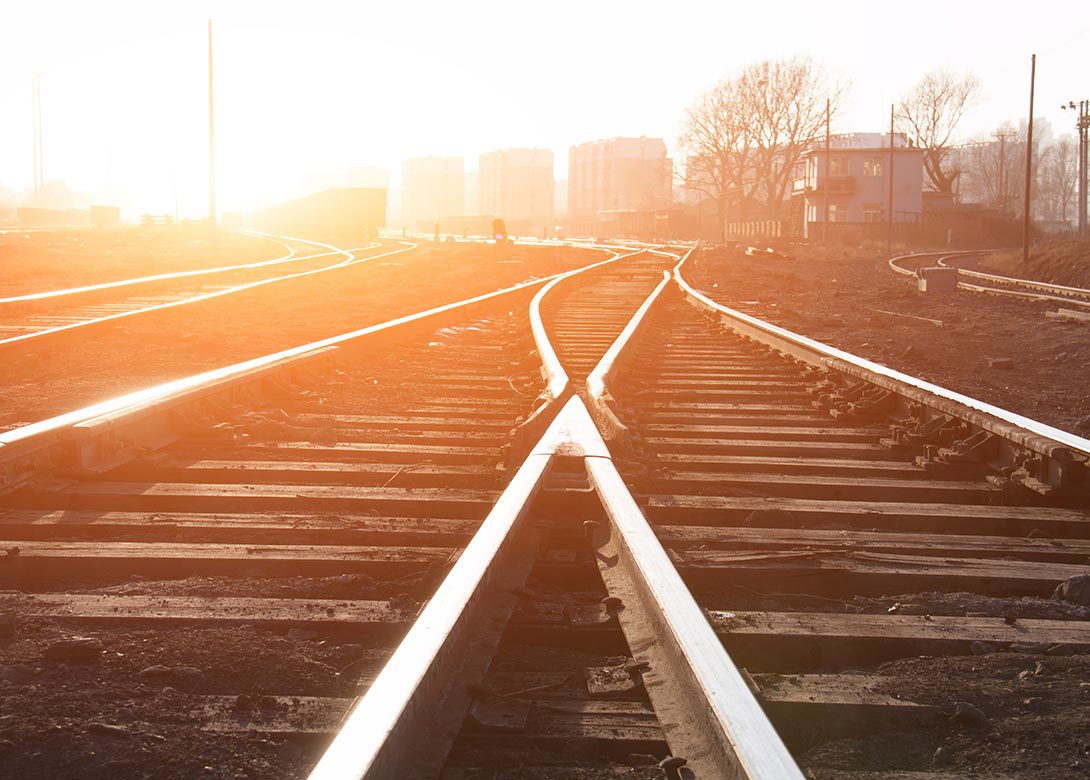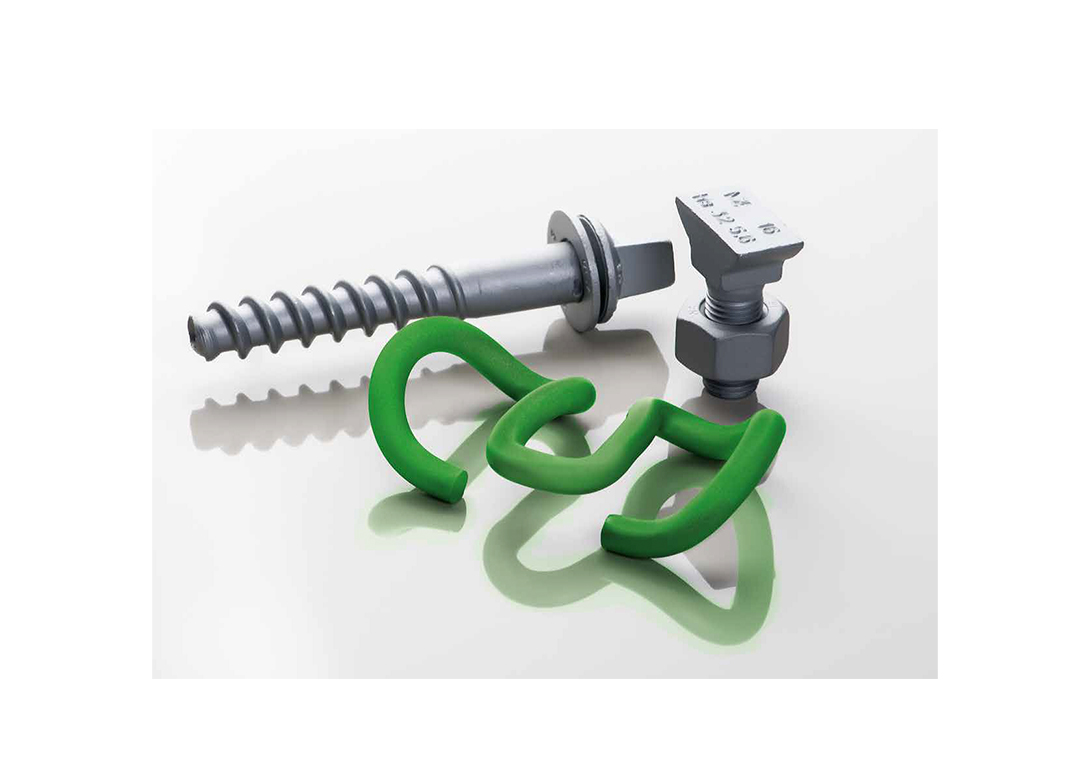
Rail fastening systems clamp the rail in frictional engagement and ensure a safe connection between the rail and the sleeper when forces are applied by a passing train. As a global manufacturer of rail fastening systems, Vossloh AG offers a comprehensive range of elastic and maintenance-free fastening solutions for slab tracks or ballasted tracks.
Thanks to their modular design, these maintenance-free fastening solutions can be used for the most diverse applications and load profiles – from conventional to high-speed and heavy haul lines through to urban metro and tram networks. A Vossloh rail fastening system essentially comprises four main components: The W-shaped tension clamp – screw fastened and maintenance-free; highly elastic rail pads and intermediate plates – depending on the superstructure; as well as angled guide plates and the screw-dowel combination.
The perfect interplay of these components reduces vibrations caused by unevenness in the track or the wheel and ensures both an optimum distribution of the forces acting on the rail, as well as a stable rail subsidence. This way, the entire superstructure is protected over a long life.
Pioneer and innovator
 In 1968, the first rail fasteners with a screwed elastic tension clamp were installed on a test track of the Federal German Railway. The product developed by Professor Hermann Meier stood the test and Vossloh was granted the general licence for the production of the tension clamp.
In 1968, the first rail fasteners with a screwed elastic tension clamp were installed on a test track of the Federal German Railway. The product developed by Professor Hermann Meier stood the test and Vossloh was granted the general licence for the production of the tension clamp.
Since then, numerous versions have been developed and patented to meet ever rising requirements, such as the mounting track loads caused by the continuously increasing speeds and axle loads and the resulting wear and tear of the superstructure components. About 70 current patents – just in the area of rail fastening systems – testify to Vossloh’s innovation capacity.
For decades, Vossloh has been assisting regulators around the globe in the development and perfection of their technical rules and regulations and still does so in close collaboration with universities, research institutes and engineering firms.
Today, Vossloh fasteners are largely installed on European mainline tracks and in over 70 countries worldwide, also performing their service in harsh environments and weather conditions. About 50 million tension clamps are produced every year at the company’s headquarters and main production site in Germany, as well as at other important production sites in China, the USA, Russia and Poland.
Every new development follows a coordinated process – from the idea to the design, simulation, prototyping, testing and approval – through to the final serial production. This ensures compliance with the highest efficiency and quality standards. For product adaptations to meet specific requirements, Vossloh’s own directly connected technology centre is fully equipped for the simulation of material and continuous load tests based on the customer’s own specifications or the requirements of international standards (e.g EN, AREMA, GOST and Australian Standard) or for the performance of tests under ‘real life’ conditions.
Currently, the engineers of fastening systems are working on the reduction of noise and vibrations by using novel materials for fastening components and their interplay in the overall system; the extension of superstructure life to minimise the total cost of ownership over the entire lifecycle; and finally, the education of the carbon footprint.
Components of the ‘New Generation’
All of these endeavours require continuous research in specialised technologies, as well as the examination of suitable materials, and also aim to increase the environmental compatibility, efficiency and useful life.
One outcome was the ‘New Generation’ concept, which reflects the trend towards using cost-efficient synthetic materials while at the same time retaining the system characteristics in terms of safety and functionality. It led to an optimisation of the volume and the weight of many components of the rail fastening system, which was achieved through the use of new materials with better insulation properties and/or the substitution of as many steel elements as possible by lightweight, yet highly strong glass-fibre reinforced plastic components – as well as a design that focuses on the sparing use of resources (e.g ribbed or honeycomb structures).
The new 300 NG system is a further development of the approved system 300 and the result of 40 years of experience in high-speed traffic. Its new angled guide plates, intermediate plates, and load distribution plates, are harmonised with one another and ensure reliable functionality and stability with resource saving design.
A good illustration of new materials with improved properties is the new dowel Sdue NG. Its optimised thread geometry reduces lateral forces in concrete sleepers so that sleeper and track can be preserved and the lifecycle costs are reduced. Its new dowel consists of polyoxymethylene (POM), a robust plastic material that has stood the test in industrial applications and medical devices. Its water repellent properties ensure the dowel does not absorb any moisture – an advantage in high humidity environments or tunnel projects.
Moreover, the production of the material requires less energy, which reduces the carbon footprint. The optimised tap geometry of the dowel ensures that in the upper portion of the dowel there is virtually no tangential and transverse forces and in the lower portion only low tangential forces are generated when the screw is tightened. Rather, these forces are primarily transferred down into the concrete sleeper where the transverse forces have hardly any impact on the growth of micro-cracks, which is a normal characteristic of concrete.
Optimally protected high strength steel components
Vossloh Protect is the new sustainable coating standard for its tension clamps and screws. The unique material quality of this premium coating ensures a long-term corrosion protection of high strength steel components of the rail fastening systems – also in the most adverse conditions created by the climate or industrial activities and even in case of damage.
To satisfy the highest corrosion class requirements, and achieve the best quality for the different circumstances of the application, countless test and control processes were carried out – partly taken over from other industries and adapted to the railway sector. Based on the test results, the product selection and the coating process were continuously adapted and optimised.
Vossloh reports this new premium coating offers a long-lasting corrosion protection for tension clamps, sleeper screws and T-head bolts. The cathodic corrosion protection also prevents the base material from corroding in the event of damage or defects.
Highest demands also during production
Maximum efficiency was a key consideration in the selection of the components of the coating plant to ensure that not only the product, but also the coating process itself, is sustainable. As no galvanic process is used, the production does without any environmentally harmful chemicals such as chromium compounds and heavy metals. As a result, the corrosion protection complies with the EU directives 2000/53/EC and 2002/95/EC.
Vossloh not only wants an environmentally compatible product, but also believes the manufacturing process should be sustainable. Currently, an advanced production plant for rail fastening systems is being built at the company’s headquarters in Werdohl, Germany. In this ‘Factory of the Future’ will be an increased use of alternative energies, efficient burner technology, optimum insulation of the oven systems and optimum utilisation of waste heat, which will all contribute to a reduced carbon footprint. A comprehensive carbon monitoring, which also includes the suppliers – right from the extraction of the raw materials – also considers direct and indirect greenhouse gas emissions throughout the entire life of a product in a defined application.
At the same time, the introduction of digitised processes and the most advanced automation technology will help reduce the response and cycle times and align production and handling processes, for example in logistics, to help answer the needs of Vossloh’s customers even more.

Having spent a decade in the fastener industry experiencing every facet – from steel mills, fastener manufacturers, wholesalers, distributors, as well as machinery builders and plating + coating companies, Claire has developed an in-depth knowledge of all things fasteners.
Alongside visiting numerous companies, exhibitions and conferences around the world, Claire has also interviewed high profile figures – focusing on key topics impacting the sector and making sure readers stay up to date with the latest developments within the industry.





